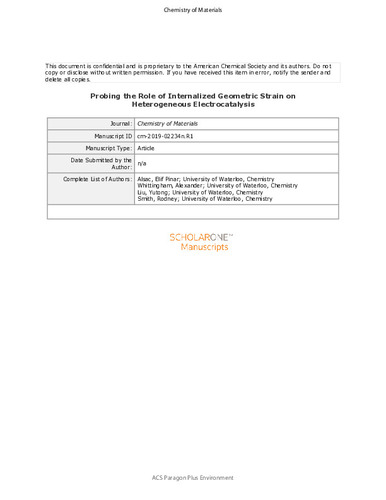| dc.contributor.author | Smith, Rodney | |
| dc.date.accessioned | 2023-05-01 17:49:16 (GMT) | |
| dc.date.available | 2023-05-01 17:49:16 (GMT) | |
| dc.date.issued | 2019-09-09 | |
| dc.identifier.uri | https://doi.org/10.1021/acs.chemmater.9b02234 | |
| dc.identifier.uri | http://hdl.handle.net/10012/19374 | |
| dc.description | This document is the unedited Author's version of a Submitted Work that was subsequently accepted for publication in Chemistry of Materials, copyright © 2019 American Chemical Society after peer review. To access the final edited and published work see https://pubs.acs.org/doi/full/10.1021/acs.chemmater.9b02234. | en |
| dc.description.abstract | The chemistry underlying the activation of nickel hydroxide toward electrocatalytic oxygen evolution by incorporation of iron remains a subject of debate. We extract insights into the role of geometric strain on the electrochemical behavior in this class of materials by blending aluminum, gallium, or iron into a disordered nickel hydroxide lattice. The electrochemical behavior and electronic structure of the three binary composition series are found to be similarly influenced by each additive cation. Density functional theory models indicate that the additive cations asymmetrically impede the voltage-induced expansion and contraction of the nickel hydroxide host lattice, a feature that is supported by near-infrared spectroscopy. Reaction coordinate diagrams suggest that this distortion decreases the activation energy for electron transfer by decreasing the extent to which the lattice can expand and contract but that iron is unique in its ability to favor oxidation by distorting the shape of the potential energy surface of the oxidized state to lower the electron transfer coefficient. These results reveal that interference with voltage-induced structural changes by incorporation of suitably sized ions alters the electrochemical behavior but that overall electrocatalytic performance cannot be linearly controlled by such geometric distortions. | en |
| dc.description.sponsorship | NSERC, RGPIN-04184-2017 | en |
| dc.language.iso | en | en |
| dc.publisher | American Chemical Society | en |
| dc.relation.ispartofseries | Chemistry of Materials; | |
| dc.subject | anions | en |
| dc.subject | lattices | en |
| dc.subject | materials | en |
| dc.subject | nickel | en |
| dc.subject | redox reactions | en |
| dc.title | Probing the Role of Internalized Geometric Strain on Heterogeneous Electrocatalysis | en |
| dc.type | Article | en |
| dcterms.bibliographicCitation | Alsaç, E. P., Whittingham, A., Liu, Y., & Smith, R. D. (2019). Probing the role of internalized geometric strain on heterogeneous electrocatalysis. Chemistry of Materials, 31(18), 7522–7530. https://doi.org/10.1021/acs.chemmater.9b02234 | en |
| uws.contributor.affiliation1 | Faculty of Science | en |
| uws.contributor.affiliation2 | Chemistry | en |
| uws.typeOfResource | Text | en |
| uws.peerReviewStatus | Reviewed | en |
| uws.scholarLevel | Faculty | en |

